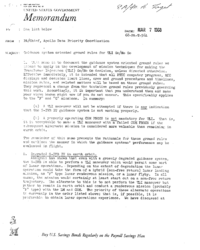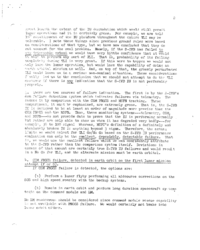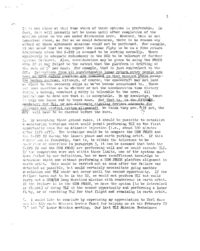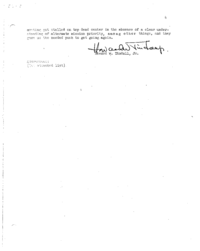See list belowMAR 7 196868-PA-T-56APA/Chief, Apollo Data Priority CoordinationGuidance system oriented ground rules for TLI Go/No Go
1. This memo is to document the guidance system oriented ground rules we intend to apply in the development of mission techniques for making the Translunar Injection (TLI) Go/No Go decision, unless directed otherwise. Effective immediately, it is intended that all RTCC computer programs, MCC displays and decision limit lines, crew and ground procedures and timelines, mission rules, and related matters will be based on these ground rules. They represent a change from the tentative ground rules previously governing this work. Accordingly, it is important that you understand them and make your views known right now if you do not concur. This specifically applies to the “F” and “G” missions. In summary:
(a) A TLI maneuver will not be attempted if there is any indication that the S-IVB IU guidance system is not working properly.
(b) A properly operating CSM PNGCS is not mandatory for TLI. That is, it is acceptable to make a TLI maneuver with a failed CSM PNGCS if the subsequent alternate mission is considered more valuable than remaining in earth orbit.
The remainder of this memo presents the rationale for these ground rules and outlines the manner in which the guidance systems' performance may be evaluated in flight.
2. Degraded S-IVB IU in earth orbit. Analysis has shown that even with a grossly degraded guidance system, the S-IVB is able to perform a TLI maneuver which would permit some sort of lunar operations. Depending on the extent of degradation the lunar operation could take the form of a hybrid (non-free return) lunar landing mission, an “F” type lunar rendezvous mission, or a lunar flyby. In all cases, the mission would certainly at least start out on a non-free return trajectory. The alternate to this is to not perform the TLI maneuver but rather to remain in earth orbit and conduct a rendezvous mission (probably “F” type) with the LM and CSM. The priority of these alternate operations is currently in the order listed above: that is, if possible, it is preferable to obtain lunar operations experience. We have discussed at great length the extent of IU degradation which would still permit lunar operations and it is certainly gross. For example, we are told 10° misalignment of the IU platform throughout the entire TLI may be tolerable. I note these things since previous ground rules were based on considerations of that type, but we have now concluded that they do not account for the real problem. Namely, if the S-IVB has failed to any detectable extent we would have very little confidence that it would be able to perform any sort of TLI. That is, probability of its failing completely during TLI is very great. If this were to happen we would not only lose the lunar operation, but would lose the capability of doing an earth orbital mission as well. And, on top of that, the grossly perturbated TLI would leave us in a serious non-nominal situation. These considerations finally led us to the conclusion that we should not attempt to do the TLI maneuver if there is any indication that the S-IVB IU is not performing properly.
3. There are two sources of failure indication. The first is by the S-IVB's own failure detection system which indicates failures via telemetry. The second is by comparison with the CSM PNGCS and MSFN tracking. These comparisons, it must be emphasized, are extremely gross. That is, the S-IVB IU is designed to be at least an order of magnitude more precise than the CSM PNCCS and the MSFN. Thus, these monitoring systems—telemetry, CSM, and MSFN—do not provide data to prove that the IU is performing normally but rather are only able to show us when it has degraded very badly—for example, 30 to 100 sigma! Whereas, MSFN's definition of a definitely and absolutely broken IU is anything beyond 3 sigma. Therefore, the actual limits we would select for TLI Go/No Go based on the S-IVB IU performance evaluation can only be the smallest, dependably, detectable failure. That is, we would use the smallest failure which we can confidently attribute to the S-IVB rather than the comparison system itself. Deviations in excess of that amount are certainly true S-IVB IU failures and would result in a No Go for TLI, and the alternate mission must be earth orbital.
4. CSM PNGCS failure, detected in earth orbit on the first lunar mission attempt (F or G). If CSM PNGCS failure is detected, the options are:
(a) Perform a lunar flyby performing all midcourse corrections on the SCS and high speed reentry with the backup systems.
(b) Remain in earth orbit and perform long duration spacecraft systems tests on the command module and LM.
No LM rendezvous should be considered since command module rescue capability is not available with PNGCS failure. We would certainly not brake into lunar orbit either.
It is not clear at this time which of these options is preferable. In fact, this will probably not be known until after completion of the mission prior to the one under discussion here. However, this is not important since, as far as we could determine, there is no reason why either of these alternate missions could not be performed. For example, it was noted that we can expect the lunar flyby to be on a free return trajectory since the S-IVB is assumed to be working normally. There apparently is adequate redundancy in the SCS to be tolerant of further systems failures. Also, consideration may be given to using the PNGCS even if it has failed to the extent that the platform is drifting at the rate of 5° per hour. For example, that is just equivalent to the SCS. Indications from all knowledgeable lunar return entry people are that no crew safety problems are involved in that mission phase using the backup systems, although, of course, the spacecraft may not land as close to the recovery ships as we've become accustomed to. There was some question as to whether or not the acceleration time history during a backup, constant g entry is tolerable to the crew. All indications to date are that it is acceptable. To my knowledge, there is only one loose end to track down. And that is, is the SXT/SCT mandatory for TLI, or are alternate sighting devices adequate for guidance and control system alignment? We think they are. If not, the SXT will have to be checked before the burn.
5. By accepting these ground rules, it should be possible to establish a monitoring technique which would permit performing TLI on the first opportunity even for an Atlantic injection (i.e., about 100 minutes after lift off). The technique would be to compare the CSM PNGCS and the S-IVB during the launch phase and earth parking orbit. If this comparison is favorable, that is, to within the tolerance to be specified as described in paragraph 3, it can be assumed that both the S-IVB IU and the CSM PNGCS are performing well and we would execute TLI. If the comparison were not within those limits, one of the systems must have failed by our definition, but we have insufficient knowledge to determine which one without performing a CSM PNGCS platform alignment in earth orbit. This would be carried out as soon after the failure was detected as possible, but would certainly necessitate going another revolution and TLI could not occur until the second opportunity. If the failure turns out to be in the IU, we would not perform TLI but would carry out a CSM/LM long duration mission with rendezvous in earth orbit. If the failure is in the CSM PNGCS, we have the option (to be determined preflight) of doing TLI at the second opportunity and performing a lunar flyby, or of scrubbing TLI for that flight and remaining in earth orbit.
6. I would like to conclude by expressing my appreciation to Carl Huss and his Alternate Mission Review Panel for helping us at his February 29 “F” and “G” Lunar Mission meeting. Our last TLI Mission Techniques meeting got stalled on top dead center in the absence of a clear under- standing of alternate mission priority, among other things, and they gave us the needed push to get going again.
- Mar 12, 1968 – Sixth Midcourse Phase Mission Techniques meeting (12.6σ)
- Apr 08, 1968 – Some lunar mission earth orbit phase ground rules (3.3σ)




